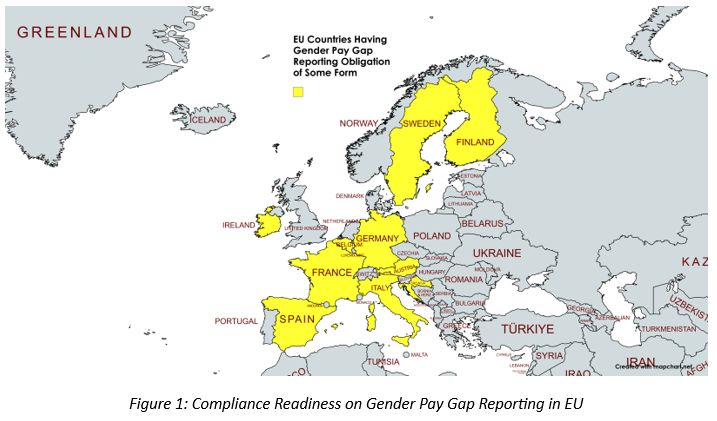- in Asia
- within Corporate/Commercial Law topic(s)
- in Asia
The EU Pay Transparency Directive (EU) 2023/970 ('Directive') marks a decisive step toward bridging the gender pay gap and fostering workplace equality. Set to take full effect by June 2026, the Directive mandates greater transparency in pay structures across EU member states. However, despite its importance, the transposition has been slow. With just over a year remaining before the transposition deadline, only a handful of member states have taken significant legislative steps toward implementing the Directive. Countries such as the Netherlands, Ireland, Poland, and Sweden have recently introduced draft laws, but these remain in various stages of the legislative process and offer only partial transposition. No EU country has yet fully integrated the Directive into its national legal framework.
One of the most notable aspects of the Directive is its empowerment of both job applicants and employees. Prospective candidates will have the right to access information about a position's initial salary or salary range before an interview, fostering informed decision-making. Additionally, employees will be entitled to request details regarding their own pay level and the average pay levels within their organization, broken down by gender. The key obligations on the employers are as follows:
- Prohibition on Asking Previous Pay:
The Directive prohibits employers from asking job applicants about their pay history during their current or previous employment relationships.
- Remove Pay Secrecy Clauses:
Employers will be obliged to remove any clause in the employment contract that restrict workers from disclosing information about their pay.
- Advertise Jobs in a Gender-Neutral Manner:
Employers will have to ensure that job vacancy notices and job titles are gender-neutral and that recruitment processes are led in a non-discriminatory manner which honours the principle of equal pay for equal work. Member states have the discretion to exempt employers with fewer than 50 workers from this obligation.
- Establish and Circulate Pay Setting and Pay Progression Policy:
Employers must make easily accessible to their workers the criteria that are used to determine their pay, pay levels and pay progression. The Directive also states that these criteria should be objective and gender neutral. Workers have the right to request and receive such information in writing and employers must provide the information within a reasonable period of time but no longer than 2 months from the date the information is requested.
- Furnish Data on Pay and Average Pay to Employees:
Every year, employers must inform all employees of their right to request information on their individual pay and average pay levels. This information must be provided in writing and broken down by sex for colleagues doing the same work or work of equal value.
- Reporting on Pay Gap Between Female and Male Workers:
Employers will be required pay disparities among worker categories to the statutory authority, including data on the overall gender pay gap, differences and medians for both basic wages and complementary/variable components, the proportion of female and male workers receiving variable pay, and the distribution of workers across quartile pay bands and worker types. The reporting requirement will be applicable to employers in the following manner:
- Employers with 250 workers or more will be required to report by June 7, 2027, and every year thereafter;
- Employers with 150 to 249 workers will be required to report by June 7, 2027, and every three years thereafter;
- Every employer with 100 to 149 workers will be required to report by June 7, 2031, and every three years thereafter; and
- Employers with less than 100 workers can make reports on a voluntary basis or as per the relevant national law.
- Joint Pay Assessment:
The Directive introduces the obligation on the employer to carry out a joint pay assessment in case the following conditions are met:
- the pay reporting demonstrates a difference in the average pay level between female and male workers of at least 5 % in any category of workers;
- the difference in average pay level is not justified on the basis of objective, gender-neutral criteria; and
- the employer has failed to remedy the unjustified difference in average pay level within 6 months from the date of submission of the report.
The assessment must be carried out to identify, remedy, and prevent differences in pay between female and male workers, which are not justified by objective, gender-neutral criteria.
Conclusion:
Several EU nations, such as Italy, Ireland, France, and Sweden, already mandate gender pay reporting, making their transition to the EU Directive relatively smoother. On the other hand, countries such as Latvia and Luxembourg lack established compliance frameworks, hence businesses there will have to invest considerable resources to adjust their pay structures, boost transparency, and align with the new reporting requirements. Figure 1 presents an infographic map highlighting in yellow the EU countries that currently mandate some form of gender pay gap reporting, offering a clear visual overview of the varying levels of compliance across the region.

Additionally, it will be interesting to see how member states tailor the Directive to fit their respective legal frameworks. Member states have the flexibility to either meet the minimum standards or go beyond them. For instance, some countries might choose to gold-plate the Directive by lowering the reporting threshold below 100 employees or by introducing stricter or additional measures.
The EU Pay Transparency Directive introduces a host of additional compliance obligations for companies, resulting in a substantial administrative burden and associated costs. Navigating these new requirements will be challenging for businesses, especially those with limited resources or experience in managing complex regulatory frameworks. As member states and organizations adapt to these changes, it will be interesting to see how they approach the complex compliance demands and address them effectively.
The content of this article is intended to provide a general guide to the subject matter. Specialist advice should be sought about your specific circumstances.


